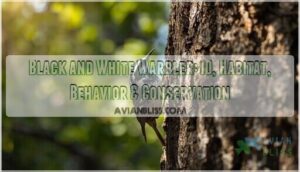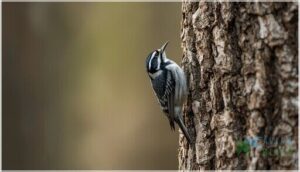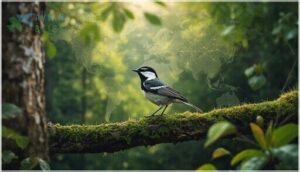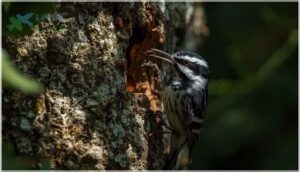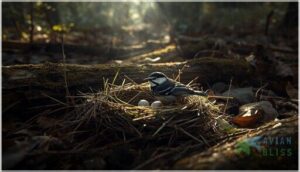This site is supported by our readers. We may earn a commission, at no cost to you, if you purchase through links.
Most warblers spend their days flitting through leaves and branches. The black and white warbler took a different path. This small songbird ditched the typical warbler playbook and evolved to climb tree bark like a nuthatch.
Its striped plumage acts as camouflage against mottled bark, while specialized toe structures grip every crevice. You’ll spot this bird creeping headfirst down tree trunks across North American forests, probing for hidden insects that other warblers can’t reach.
This unique adaptation lets it exploit a food source most songbirds ignore. Understanding how to identify this species and recognize its distinctive behavior will help you appreciate one of nature’s clever solutions to competition.
Table Of Contents
- Key Takeaways
- Black-and-white Warbler Identification
- Habitat and Geographic Range
- Behavior and Unique Adaptations
- Diet and Feeding Habits
- Nesting, Threats, and Conservation
- Frequently Asked Questions (FAQs)
- What do black & white warblers look like?
- What does a Black-and-white Warbler eat?
- Where do black and white warblers live?
- What is a black-and-white warbler?
- Are black and white warblers related?
- Are black-and-white warblers at risk of being parasitized by cowbirds?
- How rare is a Black-and-white Warbler?
- What bird looks like a Black-and-white Warbler?
- Are Black-and-white Warblers migratory?
- What is the name of a bird that is black and white?
- Conclusion
Key Takeaways
- The black and white warbler evolved a unique niche by foraging on tree bark like a nuthatch instead of flitting through foliage like typical warblers, using specialized toe structures and a slightly curved bill to extract insects from bark crevices that other songbirds can’t access.
- This species undertakes long-distance migrations spanning thousands of miles between breeding grounds across eastern North America (from Canada to northern Georgia) and wintering areas in tropical forests from Mexico through Central America and northern South America.
- Ground-nesting behavior makes these warblers vulnerable to predators like raccoons and skunks (with nest predation rates exceeding 40% in fragmented habitats) and to brown-headed cowbird parasitism (affecting up to 30% of nests), which significantly reduces fledgling success.
- Despite being listed as Least Concern by the IUCN, black and white warbler populations have declined roughly 47% in some regions over 50 years due to habitat fragmentation, logging, urbanization, and climate change impacts on prey availability.
Black-and-white Warbler Identification
You can spot a Black-and-white Warbler by its striking striped pattern and unique shape.
These small songbirds have features that set them apart from other warblers you might encounter. Let’s break down the key identification markers that will help you recognize this species in the field.
Size and Shape
You’ll recognize the Black-and-white Warbler by its compact bird size and shape. Body length spans 11 to 13 cm, with a wingspan ratio of 18 to 22 cm compared to its weight of just 8 to 15 grams. The bill morphology features a slightly downcurved design, perfect for foraging. Notice its sleek head shape, short tail length, and long wings that support its distinctive climbing behavior.
They’re known for their unique tree-creeping behavior, similar to a nuthatch.
Distinctive Plumage and Markings
The bold color pattern makes this bird unmistakable. You’ll spot black-and-white stripes running from crown to tail, creating striking crown stripes with a white median line flanked by black. Two white wing bars stand out against black wings, while facial patterns show a white eye-ring and superciliary stripe.
Look for heavy body streaking below and white tail spots on the outer feathers. They forage by creeping along branches searching for insects.
Male Vs. Female Differences
You can tell males from females by checking throat and facial markings. Males sport solid black throats and ear coverts, while females show white throats with gray cheeks. Males display darker, more contrasted plumage patterns throughout the breeding season. Females appear slightly smaller and lighter, with less defined back streaking and faint buff wash on flanks.
During courtship, females build nests and perform unique distraction displays, while males arrive first to claim territories.
Comparison With Similar Species
Beyond gender traits, you’ll want to distinguish black-and-white warblers from lookalikes. Check these key warbler identification markers:
- Blackpoll warbler – solid black cap with white cheeks
- Yellow-throated warbler – bright yellow throat and chest
- Black-throated gray warbler – yellow eye spot and gray back
- White-breasted nuthatch – stockier build, shorter tail
- Chickadee – simpler plumage distinctions and vocalizations
Watch for foraging differences too. Black-and-white warblers creep vertically on trunks, while most warblers hop through foliage. Size comparison helps – they’re sparrow-sized at 11-13 cm. Their rusty-wheel song differs from the blackpoll’s buzzy notes. Habitat comparison reveals preferences: black-and-whites favor eastern deciduous forests, versus blackpolls’ northern boreal range.
Habitat and Geographic Range
Black-and-white Warblers travel thousands of miles each year between their summer and winter homes. You’ll find these striped songbirds across a huge swath of North America, from Canadian forests down to tropical regions.
Let’s look at where they breed, what kind of forests they prefer, and how they move between these areas.
Breeding and Wintering Areas
You’ll find Black-and-white Warblers across a vast breeding range of 11.5 million square kilometers. Their territory stretches from the Northwest Territories down to North Carolina and Texas.
When winter arrives, these warblers head south to Florida, Central America, the West Indies, and as far as Peru. Population densities vary, with Nova Scotia forests hosting 15-50 pairs per square kilometer in prime habitat.
Preferred Forest Types
You’ll spot these warblers thriving in mature deciduous forests and mixed woodlands across their range. They’re particular about their habitat preferences, with densities reaching 13.4 pairs per 40 hectares in prime aspen-spruce-fir mixes.
Their preferred forest types include:
- Mature deciduous stands with large trees for foraging on trunks and branches
- Mixed deciduous-conifer forests supporting up to 9.6 pairs per 40 hectares
- Second-growth woodlands with adequate canopy cover and understory
- Forests with specific topography like dry rocky hillsides and ravines
Habitat preservation requires maintaining forest patches larger than 10 hectares.
Migration Patterns
Each spring and fall, you’ll witness these warblers undertaking striking journeys between breeding and wintering grounds. Migration timing starts surprisingly early, with northward movements beginning in late March, and individuals traveling roughly 20 miles per day through the Mississippi Valley. Black-and-white warbler migration patterns follow multiple routes across the Gulf of Mexico, with stopover sites critical for refueling.
| Migration Phase | Key Details |
|---|---|
| Spring Routes | Gulf crossings via Bahamas, Cuba, and Yucatán; overland through Texas |
| Stopover Strategy | Refueling rates increase with remaining distance to breeding grounds |
| Conservation Hazards | Night collisions with buildings, towers; pesticide exposure along routes |
Warbler migration and range connectivity mean that eastern Caribbean populations breed in eastern North America, creating a chain migration system where regional habitat loss disproportionately affects specific breeding populations.
Behavior and Unique Adaptations
Black-and-white Warblers stand out from other warblers because they move more like nuthatches than typical songbirds. You’ll notice them creeping along tree trunks and branches, switching their body side to side as they search for food.
Let’s look at the specific behaviors and adaptations that make this species so unusual.
Foraging Techniques
You’ll recognize the Black-and-white Warbler’s bark-gleaning specialization the moment you see one working a trunk like a miniature nuthatch. This foraging behavior sets it apart from typical foliage-gleaning warblers:
- Probes bark crevices with its slightly curved bill to extract caterpillars, beetles, and spiders
- Searches dead limbs where arthropod prey concentrates most densely
- Forages throughout the canopy from ground level to treetops on trunks and major branches
- Supplements with foliage-gleaning at branch tips when insects are abundant
- Occasionally employs flycatching by sallying from perches to catch airborne prey
This spatial foraging flexibility and diverse maneuver types enable effective insectivorous bird diet maintenance across seasons.
The warbler’s treecreeping behavior—moving upward, downward, and sideways on bark—exploits surfaces other warblers ignore, creating a unique niche context among North American wood-warblers.
Climbing and Creeping Habits
You can watch the Black-and-white Warbler’s striking treecreeping behavior unfold as it spirals up trunks at 0.5 meters per second—about half walking speed.
Its vertical climbing mechanics rely on specialized foot pads and microscopic toe structures that grip bark crevices with adhesion supporting 1.5 times its body weight.
This creeping motion covers 200 meters daily, yielding 40% higher insect detection rates than aerial foraging while accessing 60% of canopy arthropods unavailable to ground-feeding species.
Their creeping behavior detects 40% more insects than aerial foraging while reaching 60% of canopy arthropods other methods miss
Social and Territorial Behavior
You’ll notice Black-and-white Warblers turn fierce defenders during breeding season, with territorial behavior lasting longer than most warblers. Males actively chase off intruders and defend 0.47 to 4.2 territories per 10 hectares through aggressive pursuit.
Outside breeding, their social structure shifts—they join mixed-species foraging flocks in winter while maintaining site fidelity, often returning to the same territories yearly.
Song and Vocalizations
While defending their turf, males broadcast a distinctive high-pitched song to mark territory. You’ll hear their thin “weesy-weesy-weesy” chant—one of the highest-pitched Warbler songs and calls among wood warblers—lasting about three seconds with six to ten repetitions. Song variations occur during breeding, when males soften their tune near females.
Listen for these Blackandwhite Warbler vocalization types:
- Sharp “chip” or “pit” call notes in non-flight contexts
- Doubled “seet-seet” flight calls lasting 56-87.5 milliseconds
- Longer, faster songs with varied pitch during courtship
Spectrographic analysis reveals call frequencies between 6.6-10.8 kHz. The vocalization context matters—songs function primarily for territorial maintenance, while calls coordinate movement through forests.
Diet and Feeding Habits
Black-and-white Warblers eat what they can find while creeping along tree bark—mostly insects and spiders they pick from crevices. Their diet shifts slightly depending on the season and what’s available.
Let’s look at what these warblers eat, where they find their food, and how their menu changes throughout the year.
Primary Food Sources
You’ll find that caterpillars make up the bulk of the Black-and-white Warbler diet, especially during spring migration and breeding. This warbler diet relies heavily on dietary protein from moth and butterfly larvae gleaned through bark gleaning.
Seasonal arthropods like beetles, spiders, and leafhoppers round out their insect diet. They even snag sapsucker insects from tree wounds, showcasing opportunistic feeding habits that fuel their energy-intensive lifestyle.
Foraging Locations and Methods
You’ll spot these warblers engaging in bark gleaning along tree trunks and major limbs—they spend 70–90% of foraging time there, far more than other warblers. Their vertical stratification shows males hunting mid- to upper-canopy while females work lower zones.
They probe bark crevices methodically, occasionally adding aerial maneuvers or foliage gleaning. Substrate selection favors mature forest habitat contexts with dead branches perfect for extracting beetles and spiders.
Seasonal Diet Variations
The arthropod diversity you observe shifts dramatically with seasons. During breeding season, larvae dependency peaks—caterpillars dominate their insectivorous birds‘ menu. Migration diet broadens to beetles and ants alongside lepidopteran larvae. Wintering prey spans spiders and beetles across tropical habitats.
BlackandWhite Warbler diet composition includes:
- Spring: 60–70% moth and butterfly larvae
- Summer: Caterpillars plus beetles from sapwells
- Fall: Mixed arthropods during transit
- Winter: Generalist food source selection in mangroves
- Year-round: Spiders and daddy longlegs supplement intake
This warbler diet and feeding pattern reflects resource availability across their range.
Nesting, Threats, and Conservation
Black-and-white Warblers face unique challenges in raising their young and surviving in the wild. Understanding how these birds build their nests, what threatens them, and how their populations are holding up gives you a complete picture of their life cycle.
Let’s look at the key factors that shape their reproductive success and long-term survival.
Nest Construction and Egg Laying
You’ll find Black-and-white warbler nests tucked on the ground near tree bases, hidden by leaves. The female weaves dry leaves, bark strips, and grass into a 5-inch cup, lined with moss and hair.
She lays 4-6 creamy white eggs speckled with brown, incubating them alone for 10-12 days. Fledglings leave the nest after 8-12 days.
Predators and Parasitism
Ground nesting puts these warblers right in harm’s way. Raccoons, skunks, and domestic cats account for significant nest predation, with rates exceeding 40% in fragmented habitats. Brown-headed Cowbirds parasitize up to 30% of nests, reducing warbler fledgling success by half. You’ll notice warblers respond with:
- Concealing nests in leaf litter
- Reducing vocalizations during incubation
- Using distraction displays near predators
Habitat fragmentation doubles these threats.
Population Trends and Threats
Over roughly 50 years, you’ve seen Black-and-white warbler populations decline about 47% in Virginia and 14.9% across other regions. Habitat degradation from logging and farming has cut interior forest cover. Climate change impacts alter prey availability on wintering grounds. Demographic pressures mount as fragmentation reduces nest success. Emerging threats like road building and urbanization compound these regional declines, leaving warbler population trends pointing steadily downward.
| Threat Category | Impact on Warblers |
|---|---|
| Habitat Degradation | Forest fragmentation reduces nesting sites |
| Climate Impacts | Shifts prey timing and winter habitat quality |
| Demographic Pressures | Lower survival in fragmented forests |
| Emerging Threats | Urbanization and development intensify loss |
Conservation Status and Efforts
You’ll find the Black-and-white Warbler listed as Least Concern by the IUCN, yet population decline continues at about 0.7% annually range-wide. Conservation efforts focus on habitat preservation through sustainable forestry and forest connectivity projects.
Climate resilience strategies now shape threat mitigation programs, while monitoring research tracks breeding populations. Conservation efforts for warblers include Lights Out campaigns and bird-safe glass installations to reduce migration mortality.
Frequently Asked Questions (FAQs)
What do black & white warblers look like?
You’ll spot this small songbird by its unmistakable zebra-like stripes running crown to tail.
Males show bold black throats and cheeks, while females display softer gray facial markings with whitish throats instead.
What does a Black-and-white Warbler eat?
You could say this warbler’s diet is all about “bugging out”—feasting almost entirely on insects like beetles, caterpillars, moths, ants, and spiders, plus arthropod eggs plucked from tree bark year-round.
Where do black and white warblers live?
You’ll find these warblers breeding across eastern North America, from central Canada to northern Georgia.
During winter, they migrate south to tropical forests spanning Mexico through Central America, the Caribbean, and northern South America.
What is a black-and-white warbler?
With striped plumage like a living barcode, the black-and-white warbler is a small songbird in the genus Mniotilta.
You’ll recognize its unique creeper-like behavior, climbing tree trunks while foraging for insects across North American forests.
Are black and white warblers related?
Yes, Black-and-white Warblers are related to other avian species in the Parulidae family tree. Taxonomy shows they’re New World warblers, not Old World warblers.
Hybridization evidence with similar-looking species confirms their evolutionary distinctiveness in ornithology.
Are black-and-white warblers at risk of being parasitized by cowbirds?
Brown-headed cowbirds pose a serious threat to nesting warblers. Parasitism frequency reaches 12% in fragmented forests, reducing nest success by 22%.
Geographic risks are highest in edge habitats, impacting overall population stability and conservation status.
How rare is a Black-and-white Warbler?
The Black-and-white Warbler isn’t rare—global abundance reaches 18 million, with regional density high across suitable forests.
However, population trends show localized declines from habitat threats, making warbler conservation status a growing concern in fragmented landscapes.
What bird looks like a Black-and-white Warbler?
You might confuse Blackpoll Warblers, Yellow-throated Warblers, or Brown Creepers with Black-and-white Warblers. Similar species ID depends on habitat overlap, foraging mimicry, size comparison, and confusing plumage patterns during migration.
Are Black-and-white Warblers migratory?
These striking songbirds don’t just visit—they’re true long-distance travelers. Migration timing spans continents, showing habitat flexibility from forests to gardens, though migratory threats contribute to population decline.
Vagrant sightings occur trans-Atlantic, revealing Black-and-white Warbler migration patterns and distribution across their warbler migration and range.
What is the name of a bird that is black and white?
Many birds wear black-and-white plumage patterns, including chickadees, woodpeckers, and nuthatches. The black-and-white warbler (Mniotilta varia) stands out with its distinctive zebra-like striping and unique bark-creeping foraging behavior.
Conclusion
Studies show that a single black and white warbler consumes over 500 insects daily during peak foraging season. That appetite makes this bark-climbing specialist an essential pest controller in forest ecosystems.
You now have the tools to identify this striped songbird, understand its niche-carving adaptations, and recognize the habitat threats it faces. Watch for it creeping down tree trunks this spring—you’ll witness millions of years of evolution solving a simple problem: how to find food where others don’t look.
- https://en.wikipedia.org/wiki/Black-and-white_warbler
- https://fieldguide.mt.gov/speciesDetail.aspx?elcode=abpbx05010
- https://www.allaboutbirds.org/guide/Black-and-white_Warbler/lifehistory
- http://vabirdatlas.org/species-account/black-and-white-warbler/
- https://stateofthebirds.nhaudubon.org/bird_database/black-and-white-warbler/

